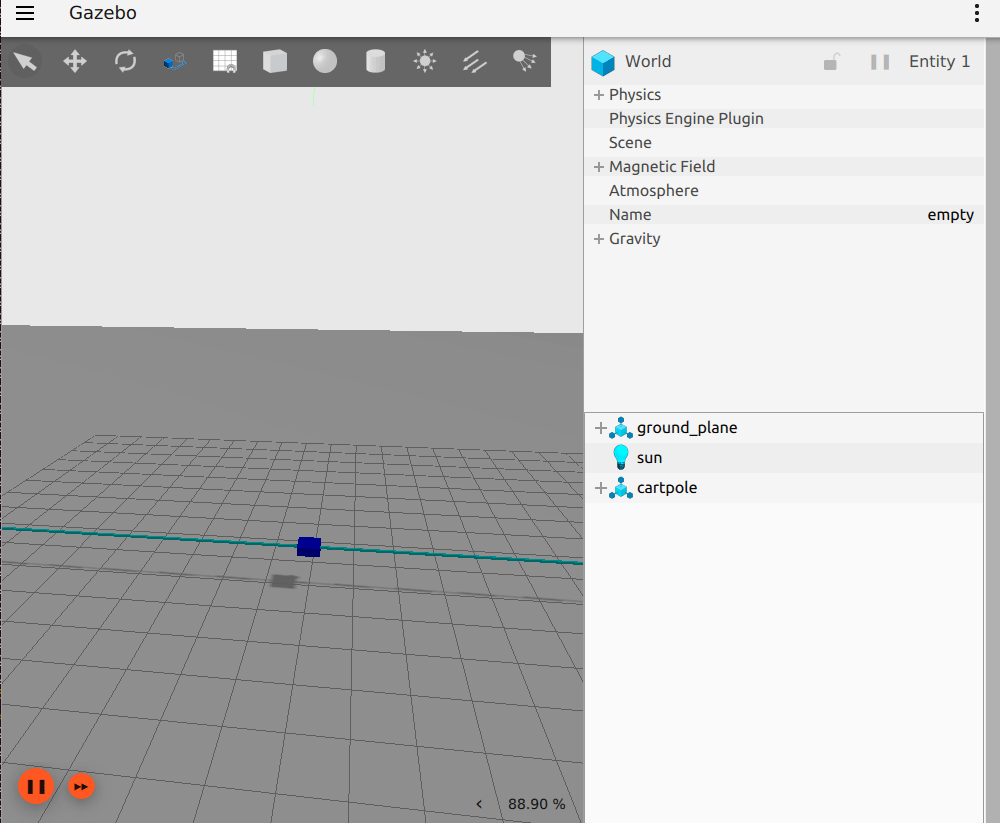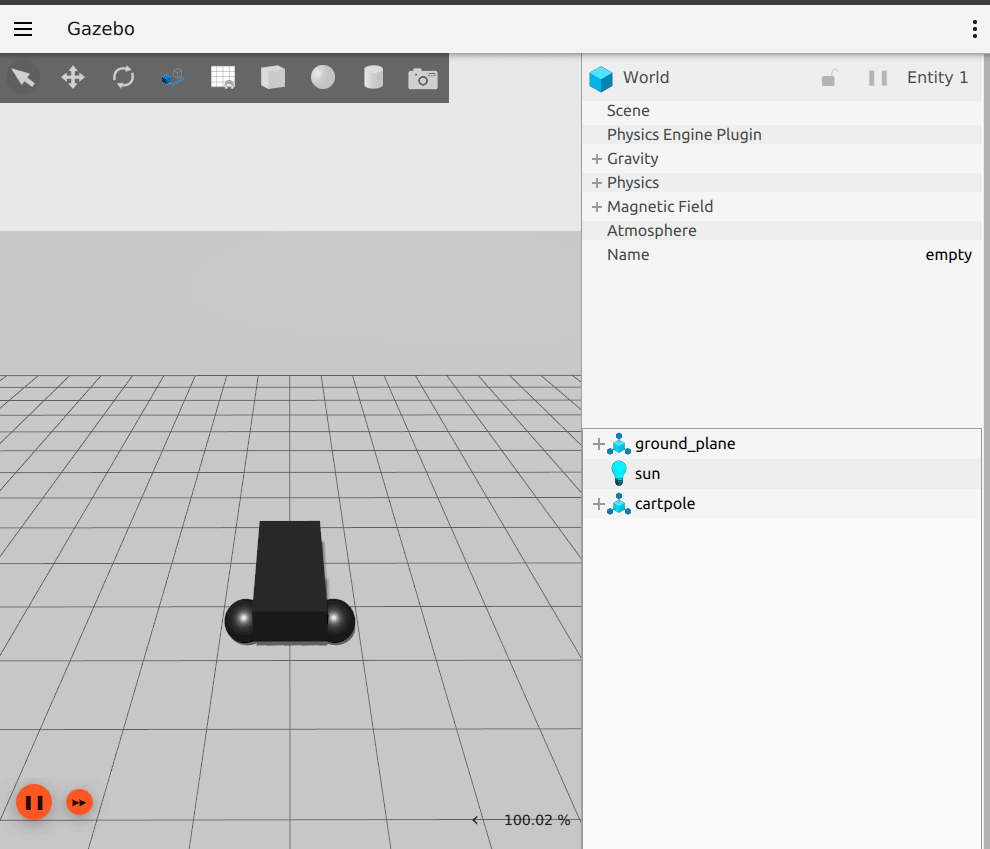Repository Summary
| Checkout URI | https://github.com/ignitionrobotics/ign_ros2_control.git |
| VCS Type | git |
| VCS Version | galactic |
| Last Updated | 2022-11-25 |
| Dev Status | MAINTAINED |
| Released | RELEASED |
| Tags | No category tags. |
| Contributing |
Help Wanted (0)
Good First Issues (0) Pull Requests to Review (0) |
Packages
| Name | Version |
|---|---|
| ign_ros2_control | 0.4.2 |
| ign_ros2_control_demos | 0.4.2 |
README
ign_ros2_control
| ROS2 Distro | Build Status | Package build |
|---|---|---|
 |
This is a ROS 2 package for integrating the ros2_control controller architecture with the Ignition Gazebo simulator.
More information about ros2_control can be found here: https://control.ros.org/
This package provides an Ignition Gazebo system plugin which instantiates a ros2_control controller manager and connects it to a Gazebo model.
| ROS version | Ignition version | Branch | Binaries hosted at |
|---|---|---|---|
| Foxy | Citadel | foxy | https://packages.ros.org |
| Foxy | Edifice | foxy | only from source |
| Galactic | Edifice | galactic | https://packages.ros.org |
| Galactic | Fortress | galactic | only from source |
| Humble | Fortress | ros2 | https://packages.ros.org |
| Rolling | Edifice | ros2 | only from source |
| Rolling | Fortress | ros2 | https://packages.ros.org |
| Rolling | Garden (not released) | ros2 | only from source |
Compile from source
If you want compile this from source, you should choose the Ignition version. The default one is citadel:
export IGNITION_VERSION=citadel
export IGNITION_VERSION=edifice
export IGNITION_VERSION=fortress
Then create a workspace, clone the repo and compile it:
mkdir -p ~/ros_ign/src
cd ~/ros_ign/src
git clone https://github.com/ignitionrobotics/ign_ros2_control
rosdep install -r --from-paths . --ignore-src --rosdistro $ROS_DISTRO -y
cd ~/ros2_ign
colcon build
Usage
Video + Pictures


Running
Modifying or building your own
cd Dockerfile
docker build -t ign_ros2_control .
To run the demo
Using Docker
Docker allows us to run the demo without the GUI if configured properly. The following command runs the demo without the GUI:
docker run -it --rm --name ignition_ros2_control_demo --net host ign_ros2_control ros2 launch ign_ros2_control_demos cart_example_position.launch.py gui:=false
Then on your local machine, you can run the Gazebo client:
ign gazebo -g
Using Rocker
To run the demo with the GUI, we are going to use rocker, which is a tool to run docker images with customized local support injected for things like nvidia support. Rocker also supports user id specific files for cleaner mounting file permissions. You can install this tool with the following instructions (make sure you meet all of the prerequisites).
The following command will launch Ignition:
rocker --x11 --nvidia --name ignition_ros2_control_demo ign_ros2_control:latest
The following commands allow the cart to be moved along the rail:
docker exec -it ignition_ros2_control_demo bash
source /home/ros2_ws/install/setup.bash
ros2 run ign_ros2_control_demos example_position
File truncated at 100 lines see the full file
CONTRIBUTING
Repository Summary
| Checkout URI | https://github.com/ignitionrobotics/ign_ros2_control.git |
| VCS Type | git |
| VCS Version | foxy |
| Last Updated | 2022-11-25 |
| Dev Status | MAINTAINED |
| Released | RELEASED |
| Tags | No category tags. |
| Contributing |
Help Wanted (0)
Good First Issues (0) Pull Requests to Review (0) |
Packages
| Name | Version |
|---|---|
| ign_ros2_control | 0.1.5 |
| ign_ros2_control_demos | 0.1.5 |
README
ign_ros2_control
| ROS2 Distro | Build Status | Package build |
|---|---|---|
 |
This is a ROS 2 package for integrating the ros2_control controller architecture with the Ignition Gazebo simulator.
More information about ros2_control can be found here: https://control.ros.org/
This package provides an Ignition Gazebo system plugin which instantiates a ros2_control controller manager and connects it to a Gazebo model.
| ROS version | Ignition version | Branch | Binaries hosted at |
|---|---|---|---|
| Foxy | Citadel | foxy | https://packages.ros.org |
| Foxy | Edifice | foxy | only from source |
| Galactic | Edifice | galactic | https://packages.ros.org |
| Galactic | Fortress | galactic | only from source |
| Humble | Fortress | ros2 | https://packages.ros.org |
| Rolling | Edifice | ros2 | only from source |
| Rolling | Fortress | ros2 | https://packages.ros.org |
| Rolling | Garden (not released) | ros2 | only from source |
Compile from source
If you want compile this from source, you should choose the Ignition version. The default one is citadel:
export IGNITION_VERSION=citadel
export IGNITION_VERSION=edifice
export IGNITION_VERSION=fortress
Then create a workspace, clone the repo and compile it:
mkdir -p ~/ros_ign/src
cd ~/ros_ign/src
git clone https://github.com/ignitionrobotics/ign_ros2_control
rosdep install -r --from-paths . --ignore-src --rosdistro $ROS_DISTRO -y
cd ~/ros2_ign
colcon build
Usage
Video + Pictures


Running
Modifying or building your own
cd Dockerfile
docker build -t ign_ros2_control .
To run the demo
Using Docker
Docker allows us to run the demo without the GUI if configured properly. The following command runs the demo without the GUI:
docker run -it --rm --name ignition_ros2_control_demo --net host ign_ros2_control ros2 launch ign_ros2_control_demos cart_example_position.launch.py gui:=false
Then on your local machine, you can run the Gazebo client:
ign gazebo -g
Using Rocker
To run the demo with the GUI, we are going to use rocker, which is a tool to run docker images with customized local support injected for things like nvidia support. Rocker also supports user id specific files for cleaner mounting file permissions. You can install this tool with the following instructions (make sure you meet all of the prerequisites).
The following command will launch Ignition:
rocker --x11 --nvidia --name ignition_ros2_control_demo ign_ros2_control:latest
The following commands allow the cart to be moved along the rail:
docker exec -it ignition_ros2_control_demo bash
source /home/ros2_ws/install/setup.bash
ros2 run ign_ros2_control_demos example_position
File truncated at 100 lines see the full file
